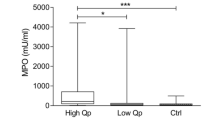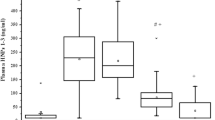Abstract
To measure serum monocyte chemotactic protein-1 (MCP-1) in patients with congenital diaphragmatic hernia (CDH) and investigate its relationship to the development of persistent pulmonary hypertension (PPH). Serum MCP-1 was measured in 13 neonates with high risk for CDH at the time of diagnosis and postoperatively, and in five age-matched controls using an ELISA system. The 13 CDH subjects were divided into four groups according to the presence of PPH and outcome. Group I (severe-pre group): subjects with severe PPH who died prior to surgery (n = 5); Group II (mild-pre group): subjects with mild PPH controlled by medications (n = 8); Group IIa (severe-post group): subjects who subsequently developed severe PPH postoperatively and died (n = 3); and Group IIb (mild-post group): subjects who continued to have mild PPH controlled by medications. We also examined nitrofen-induced hypoplastic lungs from five rat fetuses with CDH and five control lung specimens for MCP-1 using immunohistochemistry. Mean serum MCP-1 in Group I was (1038.0 ± 95.8 pg/ml), which was significantly higher than Group II (444.9 ± 39.7 pg/ml) (P < 0.0001) and controls (147.3 ± 11.3 pg/ml) (P < 0.0001). Postoperatively, Group IIa was significantly higher than Group IIb from 24 to 120 h postoperatively (P < 0.001). In Group IIb serum MCP-1 did not rise at all between 24 and 120 h postoperatively. Hypoplastic fetal rat CDH lungs had strong expression of MCP-1 compared with control lungs. Up-regulated expression and high circulating levels of MCP-1 in CDH patients with PPH suggest that MCP-1 may play a role in the development of PPH in CDH.



Similar content being viewed by others
References
Joanne C, Carol B, Jan ED et al (2005) Outcomes of congenital diaphragmatic hernia: a population-based study in Western Australia. Pediatrics 116:356–363
Damas JK, Kari O, Arne Y et al (2004) Soluble CD40 ligand in pulmonary arterial hypertension possible pathogenic role of the interaction between platelets and endothelial cells. Circulation 110:999–1005
Wagenvoort CA, Wagenvoort N (1970) Primary pulmonary hypertension: a pathologic study of the lung vessels in 156 clinically diagnosed cases. Circulation 42:1163–1181
Veyssier-Belot C, Cacoub P (1999) Role of endothelial and smooth muscle cells in the pathophysiology and treatment management of pulmonary hypertension. Cardiovasc Res 44:274–282
Kobayashi H, Yamataka A, Okazaki T et al (2004) Increased levels of circulating adhesion molecules in neonates with congenital diaphragmatic hernia complicated by persistent pulmonary hypertension. Pediatr Surg Int 20:19–23
Molenaar JC, Bos AP, Hazebroek FWJ et al (1991) Congenital diaphragmatic hernia: What defect? J Pediatr Surg 26:248–254
Wilcox DT, Irish MS, Holm BA et al (1996) Pulmonary parenchymal abnormalities in congenital diaphragmatic hernia. Clin Perinatol 23:771–779
Geggel RL, Murphy JD, Langleben D et al (1985) Congenital diaphragmatic hernia: arterial structural changes and persistent pulmonary hypertension after surgical repair. J Pediatr 107:457–464
Tuber RM, Voelkel NF (1998) Pulmonary hypertension and inflammation. J Lab Clin Med 132:16–24
Humbert M, Monti G, Fartoukh M et al (1995) Increased interleukin-1 and interleukin-6 serum concentrations in severe primary pulmonary hypertension. Am J Respir Crit Care Med 151:1628–1631
Dorfmuller P, Zarka V, Durand-Gasselin I et al (2002) Chemokine RANTES in severe pulmonary arterial hypertension. Am J Respir Crit Care Med 165:534–539
Fartoukh M, Emilie D, Le Gall C et al (1998) Chemokine macrophage inflammatory protein-1( mRNA expression in lung biopsy specimens of primary pulmonary hypertension. Chest 114:50S–51S
Kimura H, Okada O, Tanabe N et al (2001) Plasma monocyte chemoattractant protein-1 and pulmonary vascular resistance in chronic thromboembolic pulmonary hypertension. Am J Respir Crit Care Med 164:319–324
Hashimoto K, Nakamura K, Fujio H et al (2004) Epoprostenol therapy decreases elevated circulating levels of monocyte chemoattractant protein-1 in patients with primary pulmonary hypertension. Circ J 68:227–231
Rollins BJ, Yoshimura T, Leonard EJ et al (1990) Cytokine-activated human endothelial cells synthesize and secrete a monocyte chemoattractant, MCP-1/JE. Am J Pathol 136:1229–1233
Sica A, Wang JM, Colotta F et al (1990) Monocyte chemotactic and activating factor gene expression induced in endothelial cells by IL-1 and tumor necrosis factor. J immunol 144:3034–3038
Rollins BJ (1997) Chemokines. Blood 90:909–928
Luster AD (1998) Chemokines: chemotactic cytokines that mediate inflammation. N Engl J Med 338:436–445
Porreca E, Di Febbo C, Reale M et al (1997) Monocyte chemotactic protein 1 (MCP-1) is a mitogen for cultured rat vascular smooth muscle cells. J Vasc Res 34:58–65
Denger S, Jahn L, Wende P et al (1999) Expression of monocyte chemoattractant protein-1 cDNA in vascular smooth muscle cells: induction of the synthetic phenotype: a possible clue to SMC differentiation in the process of atherogenesis. Atherosclerosis 144:15–23
Author information
Authors and Affiliations
Corresponding author
Rights and permissions
About this article
Cite this article
Okawada, M., Kobayashi, H., Tei, E. et al. Serum monocyte chemotactic protein-1 levels in congenital diaphragmatic hernia. Pediatr Surg Int 23, 487–491 (2007). https://doi.org/10.1007/s00383-006-1858-6
Published:
Issue Date:
DOI: https://doi.org/10.1007/s00383-006-1858-6




